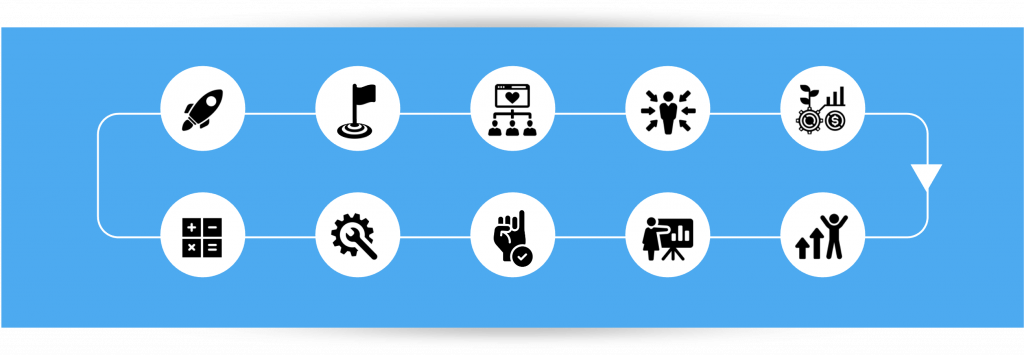How to introduce a
loyalty program
10 Step Guide
How to introduce a loyalty program that all your stakeholders will love
The past months have shown: companies that have a Loyalty Program are in a better position to communicate directly with their customers, even in times of closed stores.
But even before the pandemic hit and shut down the direct connection between customer and brand, 8 in 10 CEOs thought of a Loyalty Program being on top of their to do list.
Why is that and how hard is it really to introduce one? Let’s look deeper.
First of all, knowing the customer and acting upon their needs has been key in retail for decades. A personalized way of offering goods and services at the right time and the right place, with the resources being allocated in an optimized way is what should be achieved.
With technology evolving, this has become easier to achieve on a bigger scale but also harder at the same time. Companies dwell in a lot of data, from online customer behavior to purchase data.
You might think that introducing a Loyalty or Rewards Program will just be another way of making your customers purchase yet another time.
But really it is only one of the reasons why a customer will engage with your brand on a deeper level.
To build strong customer relationships, like in all relationships, a deeper level of understanding and acting upon these insights is necessary.
This way you will not just push another coupon at the end of the year, but truly build a customer base and increase customer lifetime value by understanding the customer lifecycle. This is where a strong Loyalty Program will not only support the next sale, but help you collect the right data, and act upon it.
If you are a marketer, think of a Loyalty Program being your biggest campaign. The campaign will be running for years, reaching your most valuable customers. If you are unsure, how to introduce a Loyalty Program and what it takes, follow these 10 steps to launch it near time.

Structure always follows strategy, therefore, your Loyalty Program should follow a clear strategy and mission. If you are unsure what this mission should sound like, check your company’s vision and mission and tie into that. As a Loyalty Program will be very brand building, building on top of your company’s vision and mission will support it.
Nothing will kill the success of any endeavour quicker than not being able to show results. Setting the right and clear goals will help you and your team stay focused, but also it will help to show results with your company and towards all stakeholders.
Goals may be: Gathering customer addresses to start a conversation in the long run (Enrollment quota), Identify more transactions in store and online, to close the gap between online and offline, or it might just be the net promoter score to drive your marketing awareness around sustainability.
Focus on 2 main goals, make them numbers and work towards them.
Yes, your stakeholders may be your management, owners or your boss, but a Loyalty Program will only succeed if all stakeholders are on board. This may be staff in stores who will have to onboard customers – if they don’t like and support the approach, your program will fail. It may be the customer service department, that will now have to deal with additional enquiries. Get their feedback: it is valuable and in that way, their buy in as well.
This step is often underrated or not done well enough. Of course this program is for your customers only, but really put yourself in their shoes. When would they be willing to hand over data and engage with your brand? The benefits (next point) are a great way to get customers to join, but thinking the whole setup of the program from customer point of view will make it an experience and hence more successful.
We like to sketch customer processes in simple steps, then note per step, what could make it easier? what could make it a unique experience and what would delight and surprise them? Don’t limit yourself in being creative, that will follow in the later steps.
Usually the most fun part of setting up a program is defining the benefits. Don’t only think of financial benefits, but emotional ones, too.
Search for benefits you will be able to keep, make them unique and matching your brands identity. Keep looking at the vision and mission during that process. Maybe you even want to limit offerings that were previously for free.
The structure of the program (tiers vs. direct discount and points or rewards) usually follows the goals you set and the type of customers you target. If the selling cycle is usually long, long term collecting towards points might not make sense. If your brand is in the luxury range, a prestigious approach like tiers might make sense. Please always keep in mind, the program should be explained in 2 sentences. Otherwise it might be too complicated.
Do the math and calculate how much it will cost to reach your goals. Ask for guidance from agencies or colleagues in other companies what an average uplift, enrollment quota etc. might be like. Then calculate the cost of your benefits. Break the cost down to your goals: E.g: cost per new member.
This again will help you keep on track and put the initial cost into perspective.
Time to get started. You will need creative designs but also the right tools and connection to the customer facing frontends.
Plan for creative, customer frontends, the right Loyalty Tool. Make sure it comes with data storage and also easy access to the data. It should be easy to use and in your own hands at best to later test and learn.
Talk to your It, what data you will be looking to gather. The systems should be connected. Aim for a 360° customer view.
Also consider data protection as well as possible customer service inquiries to prepare your team.
Start small at launch, to be able to keep your promise. Then expand. If the program fails to deliver from start, adoption might be tricky to be achieved. It is hard to cut back on functionality when you have thought about the end result for so long. After all, the program should be a great success, but believe me, starting small and growing has always helped to reaching the goal quicker with less pitfalls.
After a couple of weeks of the program running, start measuring against your goals. Maybe you can even showcase some other numbers that will underpin the effect of introducing the program. Also get feedback from stores or customers directly. The group of enrolled members might still be small, use this situation to adapt quickly.
With data pouring in, you have already reached your main goal, a direct channel to communicate with your customers has been established. But don’t stop learning. The “oil” which might be the data, needs refinement and that is where you learn and improve.
Offer and use the data in product design, marketing and also research. Why not ask your most loyal customers about their experience.
Keep your program engaging. That is why having a tool in place that lets you innovate and learn yourself will pay off.

